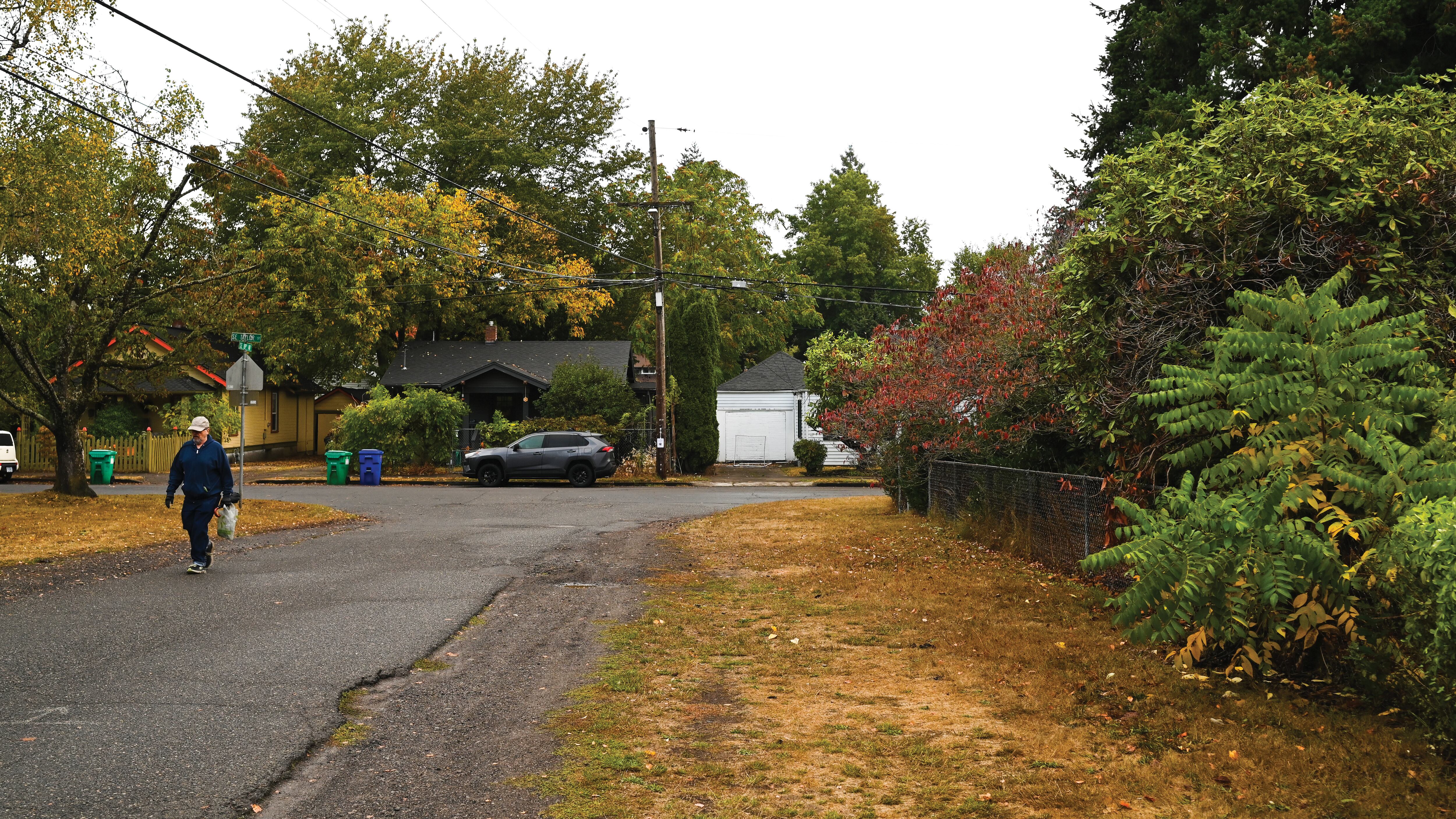On a clear September evening, 20 people gathered at Berrydale Park in the Montavilla neighborhood of Southeast Portland, the plastic feet of their lawn chairs sinking into the ground near the community garden.
The residential streets surrounding Berrydale Park are among the parts of East Portland where city transportation officials have pledged to rectify decades of neglect: roads cratered with potholes and lacking sidewalks.
And on this warm evening, a city official told neighbors of a plan to construct sidewalks along Southeast 89th Avenue and portions of Taylor Street.
Partly on their dime.
Fifteen homeowners would each be billed just under $24,000, to be exact, plus interest.
Only one homeowner could opt out—the rest could not. Portland Parks & Recreation planned a near-total renovation of Berrydale Park itself, including a new skatepark and playground. And the city decided to build sidewalks next to the park on both sides of 89th and along parts of Taylor—and bill homeowners for the cost.
Under Portland city code, homeowners are responsible for maintaining the sidewalks in front of their houses, but less often are they asked to build the sidewalks at their own expense. One circumstance in which they are: when the streets become the subject of a local improvement district, which requires contributions from nearby property owners to upgrade road conditions. That program is overseen by the Portland Bureau of Transportation, a bureau under the watch of Commissioner Jo Ann Hardesty.
For years, the Portland City Council has vowed to refocus its infrastructure efforts on the most neglected parts of town. Now it’s doing so, and the residents of those places are unhappy. They say City Hall hasn’t considered that people living in low- and middle-income neighborhoods don’t have the means to pay for upgrades that are commonplace in Laurelhurst and the Alphabet District.
On Oct. 12, the City Council voted unanimously to continue planning for the 89th Avenue project—over the objections of 12 of the 14 homeowners who would be charged. Many of them say the expense could force them to sell their homes.
“I’m on Social Security and I can’t afford any more expenses,” says Doug Voigt, 70, who purchased his home on 89th Avenue in 1991 for $46,000. “I didn’t figure I’d have to pay 24 grand for the whole neighborhood.”
Nobody questions that the streets around Berrydale Park leave something to be desired. Water pools in the gravel where a sidewalk should be on the northernmost side of 89th. The asphalt of the street blends into gravel that blends into the lawns of abutting homes. Parkgoers must walk in the street, hugging tightly to cars parked roadside.
One way to remedy such hazards: a local improvement district, a financing method for infrastructure projects that requires property owners to pool their money to cover costs. In the past 20 years, Portland has completed 58 local improvement districts. East Portland contains just 17 of them.
At the Oct. 12 hearing, PBOT program administrator Andrew Aebi told the City Council that Montavilla residents had asked for fixes to the street.
Aebi recalled a moment during a Sept. 6 meeting with neighbors as a good argument for why the street needed improvement: “As we were discussing…I heard a bloodcurdling scream behind me, and a young girl had wiped out on the street there, and she skinned her knee or something, and it was a tangible reminder that kids need safe places to be and a safe place for a young child to ride a bike.”
Neighbors who attended the meeting dispute that the scream was “bloodcurdling.” And that’s not their only bone of contention with Aebi.
“We feel like we got blindsided by this,” says Dennis Kemper, who purchased his house on 87th Avenue in 1987. “And they said the city can lien your house if you don’t pay it.”
The city offers homeowners conscripted into such projects the ability to pay the amount back over five, 10 or 20 years. Still, that could mean a $165 monthly charge for 20 years.
Voigt and Kemper are two of the 12 neighbors who signed a letter asking the City Council to kill the project due to the financial burden, especially for homeowners who are retired and living on fixed incomes.
Signatories claim none of them asked for the project.
“Our neighborhood has been dealing with issues of nearby homeless camps, on property we are told is the responsibility of PBOT,” it read, in conclusion. “It’s almost laughable that PBOT is putting their effort into forcing each of us to spend $23,000 on a project that we don’t want, when they can’t even support our neighborhood in the ways that we are asking.”
Aebi says he’s aware of the neighbors’ letter.
“I hear what the letter says,” he tells WW. “It’s intimating, ‘We don’t want to pay anything.’” But he disputes there is “anything on the written record that all 14 property owners are opposed to it.”
Moving an LID before the City Council typically requires more than 50% of the property owners who are to be burdened with the cost to sign a petition in favor of it, calculated either by total square footage or on a one-property, one-vote basis. But not this time.
The city says because the parks bureau owns most of the property in question, and will foot over three-quarters of the bill, City Hall can make the decision without the consent of nearby homeowners.
Abei says local residents have an obligation to the greater good.
“We have a one-time opportunity to piggyback on what is being built,” Aebi says. “Are we going to walk away and do nothing at all for this neighborhood, leave the potholes and the drainage problem?”
At the Oct. 12 hearing, City Commissioner Dan Ryan peppered Aebi with questions about the cost burden for retired homeowners on fixed incomes, asking if the city could offer exemptions or hardship waivers.
Abei said no—but added that the city could defer the loan for an additional five years. The Oregon Constitution mandates that cities undertake such projects, he says, “based on benefit to property, not based on ability to pay.”
When asked by Ryan later at the hearing if it was possible to pull other neighbors in after two Montavilla residents just blocks away testified they were willing to chip in, Aebi said: “I’m reluctant to cast the net wider and pull people in.”
The City Council’s unanimous Oct. 12 vote to greenlight planning for the project isn’t the final word on the matter. It simply gives Aebi permission to move forward with planning; the project must return before the council Nov. 30 for final approval. Homeowners can file grievances against the project, but only the council has ultimate authority to kill or approve it, no matter the level of support or dissent. The council can also amend the project, including its boundaries and “all matters contained in the plans and specifications,” according to city code.
Hardesty and Mayor Ted Wheeler offered strong support for the plan. Wheeler called it a “significant public good for everybody in the area,” and Hardesty said access to the park required new sidewalks.
“This community would not be satisfied,” she said, “if we put in a big, beautiful park and people had to go through mud and a lack of sidewalks and still walk in the streets to access it.”
Neighbors tell WW they see it differently.
“Most people didn’t have to pay for their sidewalks. Why are they singling us out?” Kemper says. “It’s a really profound financial hardship.”
This article was published with support from the Jackson Foundation, whose mission is: “To promote the welfare of the public of the City of Portland or the State of Oregon, or both.”

